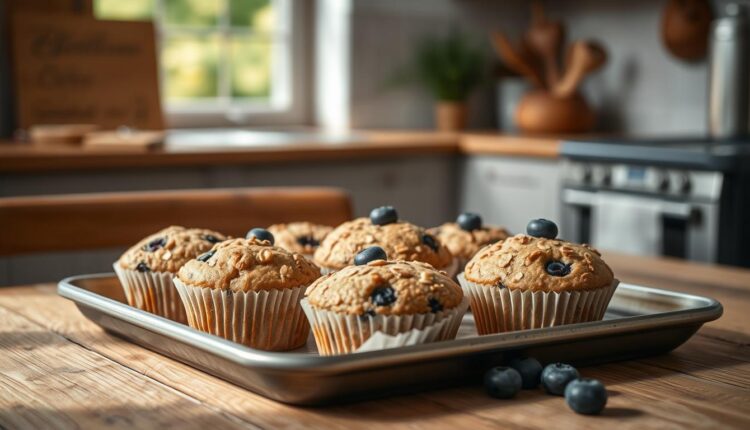Protein Breakfast Muffins For Diabetics With Blood Sugar Control
Start your day with healthy protein breakfast muffins for diabetics that support blood sugar control. Easy, grab-and-go breakfast ideas for a no-stress morning.
I once burned three batches of almond flour batter before realizing my oven runs hot—a humbling reminder that even simple bakes need attention. But when they work? Magic. These tender, nutrient-packed creations combine smart swaps (like using almond flour) with thoughtful techniques to balance flavor and blood sugar needs.
Busy mornings demand solutions that don’t sacrifice health. That’s why I teamed up with bakers like Arman Liew to refine recipes prioritizing slow-release carbs and sustained energy. The result? A collection of diabetic-friendly muffin ideas tested by home cooks managing similar dietary goals. Caledona13’s apple-almond variation became my weekly staple—moist, lightly sweetened, and ready in 25 minutes.
We’ll walk through ingredient ratios that matter, from binding agents to flavor boosts. You’ll learn why mixing methods affect texture and how to store batches for grab-and-go ease. No fancy equipment required—just bowls, spoons, and that trusty muffin tin hiding in your cabinet.
A New Approach to Healthy Mornings
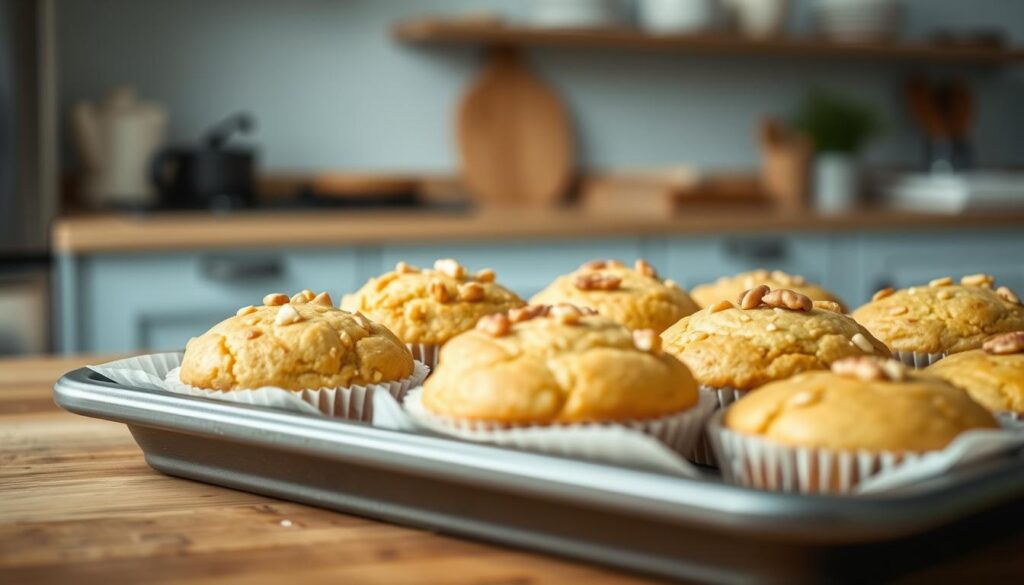
My first test batch emerged from the oven resembling damp sponges—too dense, too wet. A fellow baker suggested tossing in oats, and suddenly everything changed. That tweak became our golden rule: ingredients must multitask. They’d add texture and slow-release energy without spiking glucose levels.
Traditional recipes often prioritize fluff over function. We flipped that script. Here’s how:
| Traditional Approach | Our Method | Why It Works |
|---|---|---|
| White flour base | Almond + oat blends | Boosts fiber, cuts refined carbs |
| Granulated sugar | Applesauce + cinnamon | Natural sweetness, no crashes |
| Buttermilk | Greek yogurt | Adds moisture + protein quietly |
Early testers craved more crunch. We answered with walnut sprinkles—tiny bursts of satisfaction that keep portions honest. One mom admitted she’d “forgotten baked goods could taste this good without the guilt.”
This isn’t about deprivation. It’s crafting something that fits your life—and your lunchbox. Mix a batch Sunday night, and you’ve got allies against hectic mornings. They’re proof that small shifts (like swapping flours) can rebuild your meal rhythm from the first bite.
Delicious and Nutritious: What Makes a Diabetic-Friendly Muffin?
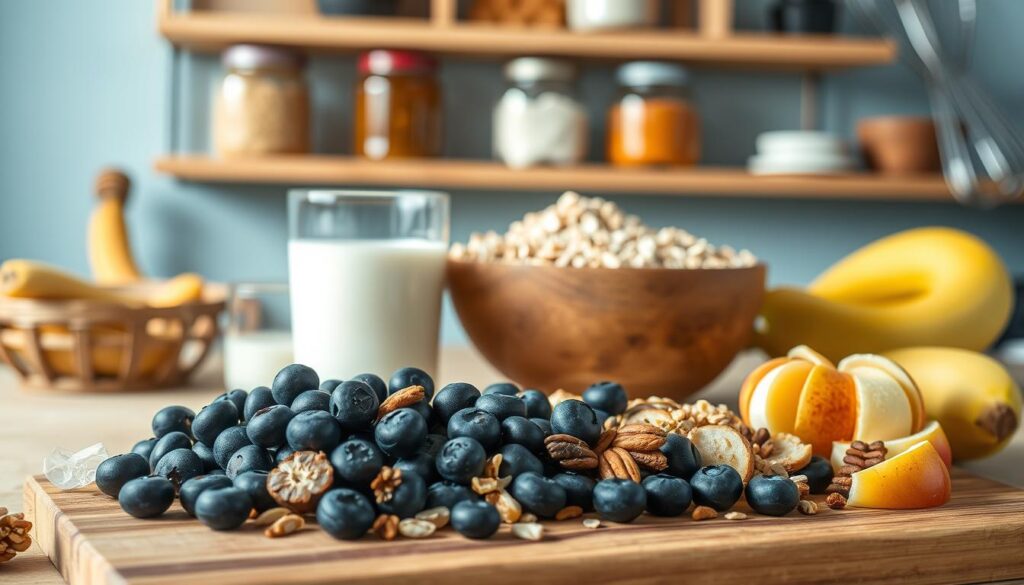
My kitchen counter once held a row of failed experiments—crumbly, bland, or oddly bitter. Then I discovered the power of intentional pairings. A meal prep pro taught me that each cup of almond flour does double duty: it adds nutty richness and keeps glucose levels steady. That’s when everything clicked.
Nutritional Benefits and Key Ingredients
Great recipes start with ingredients that earn their spot. Here’s what works:
- Almond flour – A cup replaces refined grains, adding fiber and healthy fats
- Unsweetened applesauce – Swaps in natural sweetness while keeping moisture locked in
- Dark chocolate chips (85% cacao) – Just a handful satisfies cravings without sugar spikes
One tester wrote, “These taste indulgent, but my numbers stay calm.” That’s the magic of choosing components that multitask.
Balancing Flavor and Health
In my early attempts, “healthy” meant sacrificing joy. Not anymore. A bowl of Greek yogurt adds tangy creaminess while boosting protein. Cinnamon and vanilla extract create warmth without empty calories. Even chocolate becomes an ally when used smartly—fold in a quarter-cup of chopped dark chunks for richness that lasts.
The secret? Treat every addition like a puzzle piece. Does it enhance taste and function? If yes, it stays. If not, back to the drawing board. Your mornings deserve both pleasure and purpose.
Success comes from small tweaks—like swapping flours and adding natural sweeteners—for steady blood sugar management.
The Role of Protein in Blood Sugar Control

I nearly tossed a pan of dense, gummy batter into the compost last year—until a nutritionist friend asked, “Did you balance the eggs with something acidic?” That question sparked my protein education. Now I see how strategic additions transform both texture and metabolic response.
Protein acts like a traffic cop for glucose. It slows absorption, preventing sharp spikes. This makes your morning bite more than a snack—it becomes a stabilizing force. One baker shared, “Adding two extra egg whites helped me ditch the 10 AM crash.”
But high-protein baking has quirks. Overmix batter, and you’ll get rubbery results. Underbake, and moisture turns to gumminess. Here’s what works:
- Mashed bananas add natural sweetness while keeping batter tender
- Eggs provide structure without dryness when baked at 350°F
- A dash of lemon juice counteracts chalkiness from added powders
One mom told me her kids now request “the chewy ones with nuts” instead of sugary cereals. Small wins. Remember: protein pairs best with fiber. Toss in oats or chia seeds to extend satisfaction.
Your oven matters too. Bake too hot, and proteins tighten abruptly. Too cool, and centers collapse. I keep a thermometer clipped to my rack now—no more guessing games. Trust the science, tweak with care, and watch how one ingredient shift reshapes your whole morning.
Protein Breakfast Muffins for Diabetics: Recipe Innovations
A batch of blueberry-studded batter taught me the power of cottage cheese last summer—its creamy tang transformed dense crumbs into cloud-like bites. That’s when I realized: reinventing classics starts with fearless swaps. Modern twists don’t just mimic tradition—they elevate it.
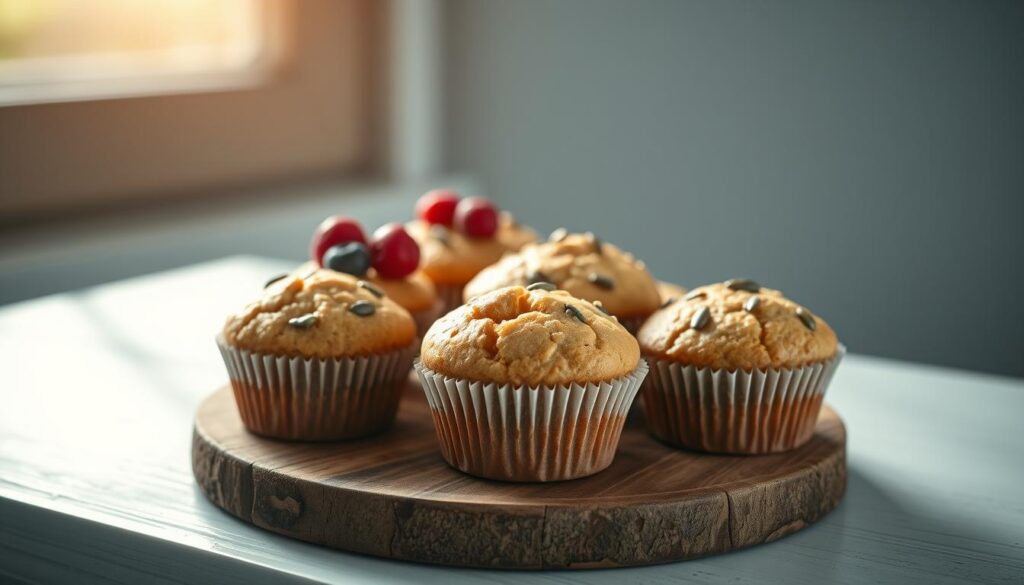
- Cheese surprises: Whipped ricotta or goat cheese add richness without heaviness (one tester called it “cheesecake vibes in every bite”)
- Fruit-forward: Mashed raspberries mixed into batter create natural sweetness pockets, cutting added sugars by 30%
- Crunchy tops: Toasted quinoa or hemp seeds replace sugary streusel for texture that satisfies
Struggling with dry results? A meal prep pro shared her fix: “Replace half the oil with pumpkin purée. You’ll lock in moisture and sneak in fiber.” This trick became my go-to for lunchbox-friendly treats that stay tender for days.
| Old Approach | New Hack | Why Better |
|---|---|---|
| White flour | Chickpea + coconut blend | Slows carb absorption |
| Milk chocolate chips | Cacao nibs + orange zest | Bold flavor, zero added sugar |
| Sour cream | Silken tofu | Boosts protein, adds creaminess |
One home cook wrote, “My family didn’t notice the black beans in the chocolate version—they just begged for thirds.” That’s the beauty of these tweaks: they’re stealthy upgrades. Your taste buds win. Your blood sugar wins. And your kitchen stays blissfully mess-free.
Ingredient Spotlight: Almond Flour, Protein Powder, and More
Last winter, a simple swap turned my crumbly disaster into a tender triumph—almond flour became my secret weapon. “Blanched varieties blend smoother and prevent gritty textures,” advised a nutritionist friend during my batter struggles. This discovery reshaped how I approach every recipe.
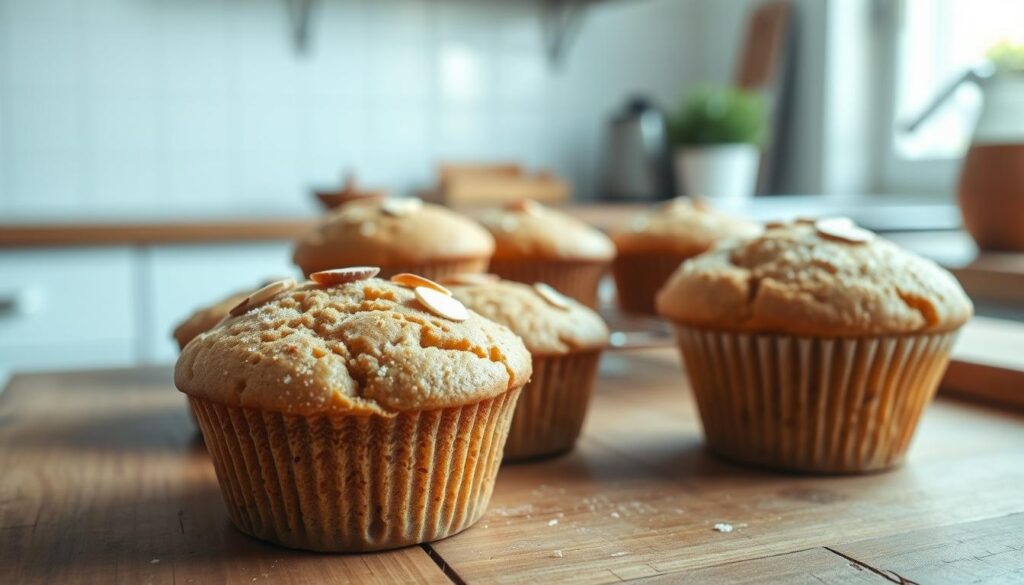
Almond Flour’s Quiet Revolution
Traditional flours left my early attempts dry or overly dense. Almond flour changed the game—its natural oils add moisture while keeping carbs low. One tester noted, “These taste like they’re cheating, but my glucose monitor stays calm.”
| Regular Flour | Almond Flour | Impact |
|---|---|---|
| Rapid glucose spike | Slow energy release | Steady blood sugar |
| Needs extra fats | Built-in richness | Simpler ingredient lists |
| Uniform texture | Nutty complexity | Depth in every bite |
Protein Powder Partnerships
My first batch with whey isolate resembled hockey pucks. Now I use brown rice or casein blends—they integrate smoothly without overwhelming flavors. A baker’s forum warns: “Whey alone creates rubbery results; mix with other powders for balance.”
| Type | Best For | Watch Out |
|---|---|---|
| Vanilla casein | Subtle sweetness | Can mute spices |
| Unflavored pea | Savory versions | Needs extra binder |
| Collagen peptides | Silky texture | Less structure |
Here’s my rule: use 1/4 cup powder per dozen. More creates dryness; less misses the high-protein boost. Pair with mashed banana or zucchini for moisture insurance. Your creations will stay tender while supporting your diet goals—no compromise required.
Test new ingredient swaps with caution—too many changes can affect texture and flavor unexpectedly.
Techniques for the Perfect Muffin Texture and Moisture

My quest for the perfect crumb led to a dozen hockey puck-like discs before I discovered the power of precise oven temps. We’ve all been there—golden tops hiding gummy centers or dry edges that crumble at first bite. Let’s fix that.
Baking Time and Temperature Insights
Preheating your oven isn’t just a suggestion. Cold starts lead to uneven rises. I learned this after three batches of sunken middles. Set it to 350°F—hot enough to activate baking powder gently but not scorch delicate almond blends.
| Oven Temp | Result | Fix |
|---|---|---|
| Too High (375°F+) | Burnt tops, raw centers | Use an oven thermometer |
| Too Low (325°F) | Dense texture | Extend bake minutes by 3-5 |
| Perfect (350°F) | Even rise, tender crumb | Trust the timer |
Moisture Retention and Texture Tips
Fat matters, but balance is key. One tester’s “greasy muffin tops” taught me to mix melted coconut oil with applesauce. This duo keeps treats moist without weighing them down. And always measure your cup almond flour lightly—packing it creates dryness.
| Ingredient | Role | Pro Tip |
|---|---|---|
| Baking Powder | Lift agent | Replace every 6 months |
| Greek Yogurt | Moisture + tang | Swap for 25% of fats |
| Egg Whites | Structure | Whip to soft peaks for airiness |
A baker friend once said, “Timers are guidelines, not gods.” Check at 18 bake minutes—if tops spring back, they’re done. Let them cool 10 minutes in the pan. This steams the interior just enough to prevent Sahara-level dryness.
Overmixing or underbaking can lead to dense or gummy muffins—ensure even baking for the right texture.
Flavor Variations and Customizable Options

I once brought a tray of lemon-poppyseed creations to a brunch, only to watch guests raid the plate before touching the pancakes. That’s when I realized: flavor freedom isn’t just fun—it’s essential. Your mix-ins should mirror your cravings while keeping nutrition goals intact.
Fruit-Inspired Twists
Fresh blueberries folded into batter add bursts of sweetness without refined sugar. Try swirling mashed raspberries into vanilla batter—their tartness balances the richness of almond flour beautifully. For autumn vibes, diced apples tossed with cinnamon create cozy warmth in every bite.
| Classic Add-In | Smart Swap | Benefit |
|---|---|---|
| Dried cranberries | Fresh pomegranate seeds | Lower sugar, higher crunch |
| Milk chocolate | Freeze-dried strawberries | Bright flavor, no added sweeteners |
| Honey drizzle | Unsweetened applesauce | Natural moisture boost |
Nutty, Chocolate, and Savory Mix-Ins
Crushed walnuts add earthy depth, while cacao nibs deliver bitter-chocolate satisfaction. For savory lovers, try rosemary and sun-dried tomatoes—they pair surprisingly well with goat cheese crumbles. Just remember: measure mix-ins carefully. Too many nuts create dense servings; too little butter leaves textures dry.
Here’s my golden ratio for success:
- 1/4 cup chopped nuts per dozen
- 2 tbsp cacao nibs (or sugar-free chips)
- 1 tsp herbs for savory versions
One reader shared, “Adding orange zest to dark chocolate chunks made my kids forget about candy.” That’s the power of thoughtful customization. Spend time experimenting—your perfect combination awaits.
Adapting Recipes for Diabetic Dietary Needs and Practical Tips
I once spent an entire Saturday testing six variations of zucchini bread—some too sweet, others oddly metallic. Then I swapped applesauce for pumpkin purée. The result? Moist, spiced perfection that kept my glucose levels steady. That’s when I realized: small tweaks can transform any recipe into a blood sugar-friendly ally.
Ingredient Swaps for Better Nutrition
Smart substitutions turn ordinary bakes into nutritional powerhouses. Try these tested swaps:
| Traditional | Diabetic-Friendly | Benefit |
|---|---|---|
| Oil | Plain Greek yogurt | Cuts fat, adds probiotics |
| Sugar | Mashed blueberries | Boosts antioxidants |
| Butter | Pumpkin purée | Adds fiber, beta-carotene |
“Using pumpkin instead of oil gave my banana bread a velvety texture—and my numbers stayed under 140!”
Timing matters. Check baked goods 3-5 mins earlier than recipes suggest. Almond flour blends brown faster. Use a toothpick test at 18 minutes for standard batches.
Blueberries shine as natural sweeteners. Fold a half-cup into batter for juicy bursts. Their low glycemic impact makes them ideal for morning treats.
Three steps to modify any recipe:
- Replace 25% of flour with oat fiber
- Use unsweetened yogurt instead of sour cream
- Halve added sugars, add cinnamon for warmth
One reader shared: “These changes helped me enjoy baking again without glucose rollercoasters.” Track your adjustments in a notebook—what works for pumpkin bars might transform your morning routine.
High oven temperatures can cause burnt tops with raw centers—always use a thermometer for accurate baking.
Conclusion
I handed a warm batch to my neighbor last week—her skeptical “healthy baked goods?” frown flipped to delight after one bite. That moment captures everything we’ve covered: smart ingredient choices create satisfying results that respect your body’s needs.
Remember, swapping white flour for nut blends or mashing banana into batter isn’t just about nutrition—it reshapes texture and prep simplicity. Those tiny tweaks add up. One reader shared how replacing half her oil with applesauce gave lemon-blueberry loaves a springy crumb her kids now request weekly.
Keep these essentials in your back pocket:
• Test binding agents like chia seeds if batters feel too loose
• Let mixes rest 5 minutes before baking for ideal rise
• Freeze extras in portions—they reheat like fresh
Your creations might not look Instagram-perfect every time (my lopsided pumpkin-chocolate chip experiment proves it). But each slightly messy bite still delivers steady energy and pride in nourishing yourself well. Share your wins and wobbles with others—we’re all rewriting what “healthy” means, one golden-brown top at a time.
Cinnamon-Apple Almond Protein Muffins
Moist, protein-packed muffins with almond flour, Greek yogurt, and fresh apples for sustained energy without blood sugar spikes. Perfect for busy mornings.
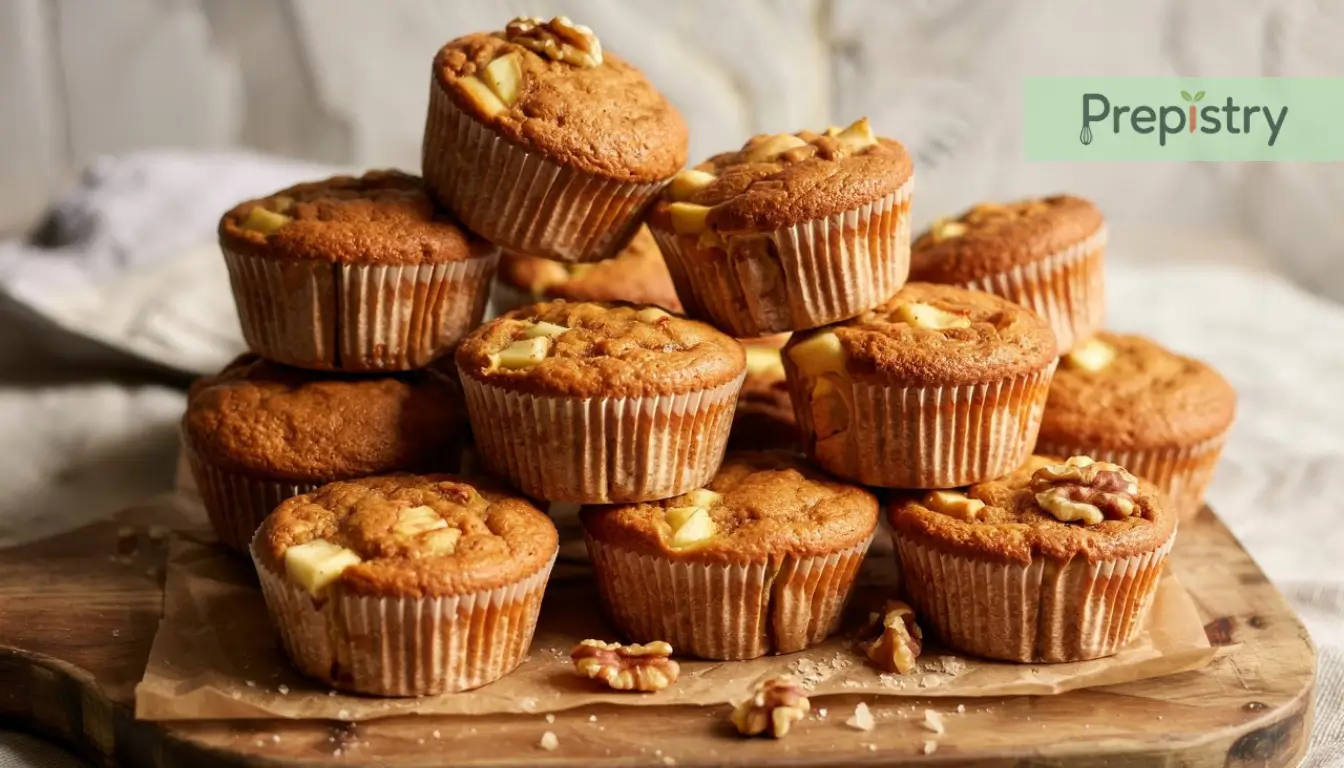
Nutrition Information
Equipment Needed
- Muffin tin
- Mixing bowls
- Whisk
- Measuring cups/spoons
Ingredients
-
2 cups blanched almond flour
-
1/4 cup vanilla whey-casein protein powder blend
-
1 tsp baking soda
-
2 tsp cinnamon
-
1/4 tsp sea salt
-
3 large eggs
-
1/2 cup plain Greek yogurt (2% fat)
-
1/4 cup unsweetened applesauce
-
2 tbsp melted coconut oil
-
1 tsp vanilla extract
-
1 medium apple, finely diced (about 1 cup)
-
2 tbsp chopped walnuts (optional topping)
Instructions
Recipe Video
Apple Cinnamon Almond Flour Muffins
Steps to make Apple Cinnamon Almond Flour Muffins.

